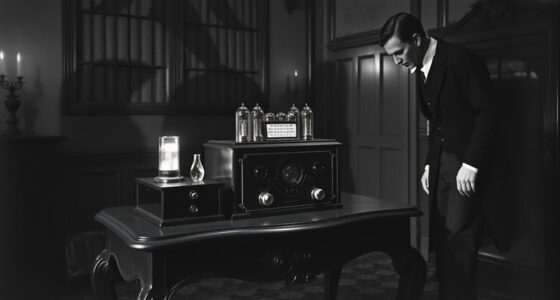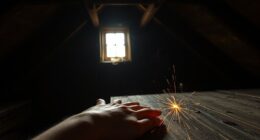In 1970, rumors of a vampire at Highgate Cemetery sparked widespread hysteria fueled by sightings, media sensationalism, and community fears. Witnesses reported shadowy figures, strange noises, and glowing eyes, which the press exaggerated to create a sense of danger. Skeptics see it as mass hysteria, while others believe folklore and imagination played roles. If you want to uncover how these stories unfolded and their lasting impact, there’s more to explore.
Key Takeaways
- The Highgate Vampire Panic originated in the early 1970s, fueled by local folklore, media sensationalism, and social hysteria.
- Witness reports described shadowy figures, glowing eyes, and strange noises around Highgate Cemetery, reinforcing supernatural beliefs.
- Media sensationalized sightings with alarming headlines, amplifying public paranoia and transforming isolated incidents into a widespread legend.
- Investigations and theories suggest mass hysteria and psychological factors, with some attributing sightings to shadows or animals.
- The event significantly impacted popular culture, inspiring books, documentaries, and debates about the supernatural.
The Origins of the Urban Legend
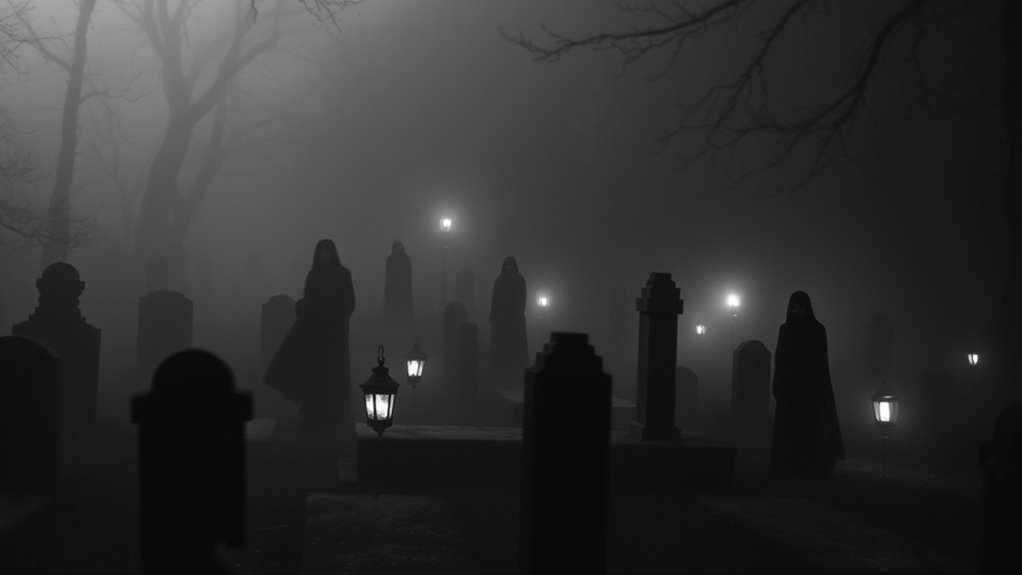
The origins of the Highgate Vampire legend are rooted in a combination of local folklore, newspaper reports, and social hysteria that spread through the community in the early 1970s. This urban legend began as stories passed down orally, blending traditional folklore origins with modern fears. As sightings and strange occurrences surfaced, local newspapers sensationalized the events, fueling the growing hysteria. The legend captured the imagination of residents, who debated whether a vampire was lurking in the cemetery’s shadows. The combination of folklore origins and media coverage created a perfect storm of urban legend that quickly took hold. You can see how the mix of old superstitions and new media amplified the myth, turning a simple tale into a widespread phenomenon. Additionally, the media influence played a crucial role in shaping public perception and accelerating the spread of the legend, illustrating how information dissemination impacts societal beliefs. The social dynamics of the community also contributed to the rapid proliferation of fear and rumor, making the legend a local sensation. The role of mass communication in disseminating rumors was particularly significant in transforming isolated stories into a collective urban myth. Recognizing the importance of media influence can help explain how stories evolve and spread quickly in modern society.
Early Sightings and Reports
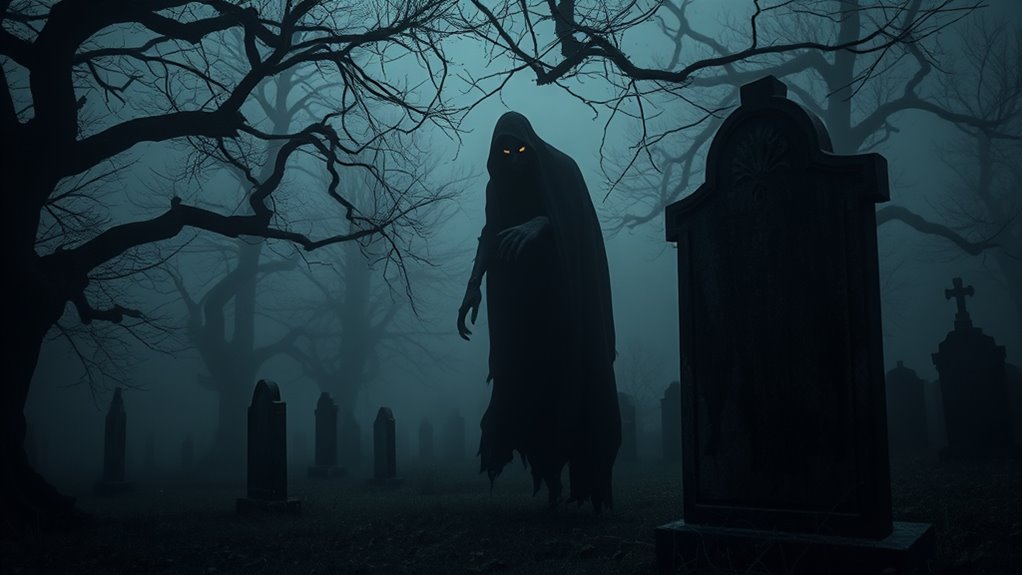
As reports of strange happenings began to surface in the early 1970s, residents and local observers couldn’t ignore the eerie occurrences around Highgate Cemetery. People started sharing stories of paranormal encounters, describing shadowy figures and unexplained sounds. These early sightings fueled urban legends, turning the cemetery into a hotspot for supernatural speculation. Some witnesses claimed to see a tall, dark figure lurking among the tombstones, while others reported feeling an icy chill even in daylight. The reports quickly spread, creating a sense of fear and curiosity in the community. To better understand these reports, here’s a quick overview:
| Witness | Description of Encounter | Impact on Local Legends |
|---|---|---|
| Local Resident | Saw a tall shadow move quickly | Sparked rumors of a vampire |
| Night Guard | Heard strange whispers | Heightened paranormal fears |
| Visitor | Felt a chilling presence | Cemented supernatural stories |
| Teenager | Saw glowing eyes at night | Boosted urban legend status |
Additionally, the mysterious nature of these sightings led many to speculate about the supernatural origins of the phenomena. Researchers and enthusiasts have since examined these reports, considering paranormal explanations that extend beyond ordinary human perception. Some experts have suggested that psychological factors could also contribute to the eerie experiences reported by witnesses, especially given the urban legend dynamics that often develop around such sites. Furthermore, the intensity of these reports has contributed to the cultural fascination with Highgate Cemetery as a site of paranormal activity.
The Role of Media in Amplifying Fear
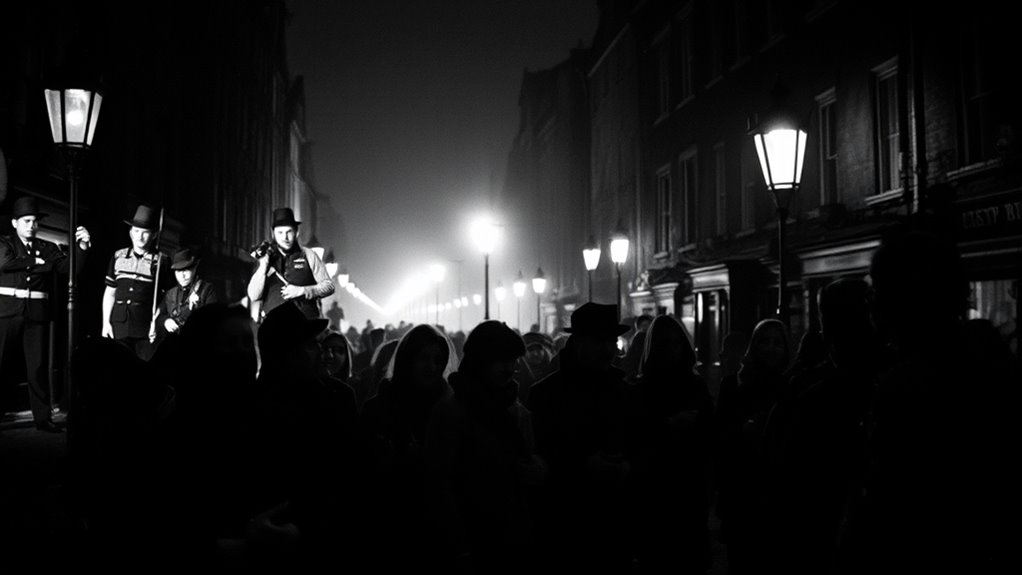
You see how sensational headlines can turn rumors into widespread panic. The media’s hype often inflates the story, making the fear seem more real and immediate. This amplification keeps the panic alive long after the initial sightings fade away. Additionally, community resources can sometimes contribute to the spread of rumors by providing unverified information. Practicing self-reflection can help communities evaluate the accuracy of information before sharing it further. Developing analytical thinking skills is also vital to discerning credible sources from misinformation during such episodes. Recognizing the importance of evidence-based techniques can further aid in assessing the validity of claims related to the panic. Promoting public awareness about the role of media can help mitigate unwarranted fears and prevent the spread of misinformation.
Sensational Headlines Drive Panic
Have sensational headlines ever fueled widespread panic? In the Highgate Vampire Panic, tabloids played a major role by using bold, alarming headlines that captivated the public. These sensational stories exaggerated sightings and supernatural threats, fueling public paranoia. Instead of straightforward reporting, tabloids prioritized sensationalism, making the vampire legend seem more real and immediate. As a result, fear spread rapidly through communities, with residents terrified of lurking monsters. The media’s focus on shocking headlines stirred anxiety and suspicion, leading many to believe in the existence of the vampire. This sensationalism transformed a local legend into a full-blown public hysteria, demonstrating how tabloid journalism can amplify fears and distort reality. The role of media in shaping perception is a powerful influence that can escalate panic beyond the original event.
Media Hype Fuels Rumors
Media outlets didn’t just report on the Highgate Vampire legend; they actively amplified it by spreading rumors and sensational stories. Media sensationalism played a key role in fueling public fears, turning whispers into widespread panic. As reports multiplied, rumor propagation intensified, blurring the line between fact and fiction. Journalists exaggerated sightings and encounters, often without evidence, which further stoked the hysteria. The media’s relentless coverage created an environment where suspicion and fear thrived. You might have seen headlines that exaggerated vampire activity, making the story seem more terrifying than it was. This sensationalism didn’t just inform the public—it fueled the frenzy, convincing many that something sinister lurked in Highgate Cemetery. The media’s role was vital in transforming a local legend into a nationwide panic.
Key Figures and Witnesses
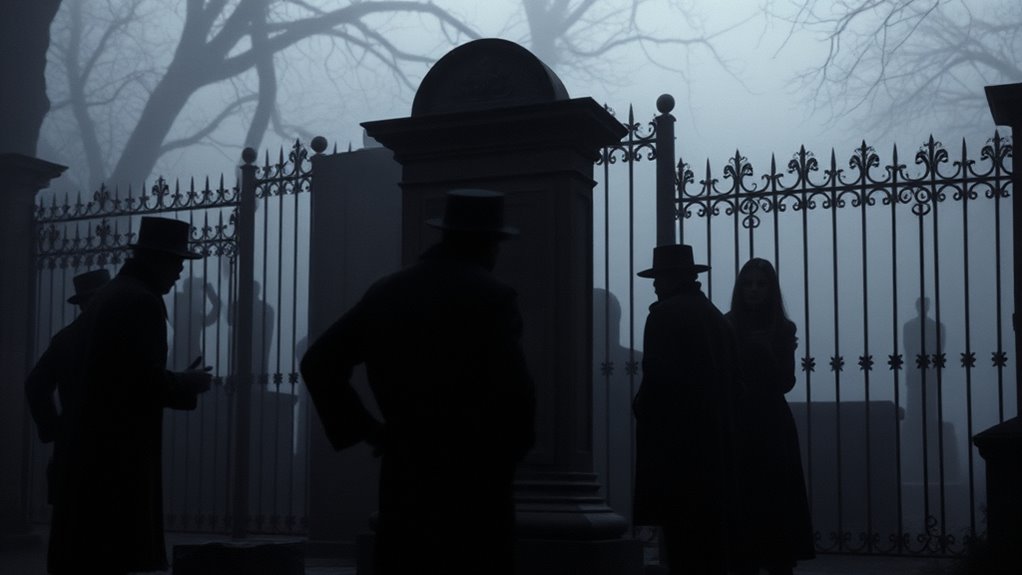
You’ll learn about the people whose stories shaped the Highgate Vampire Panic, from eyewitnesses to investigators. Their accounts reveal what was seen, heard, and believed during the events. Understanding their roles helps clarify how the story gained such widespread attention.
Notable Witnesses’ Accounts
Among the most compelling accounts of the Highgate Vampire Panic are those provided by the key witnesses who encountered the eerie figure firsthand. Their paranormal encounters left lasting impressions, fueling the hysteria. Eyewitness testimonies describe seeing a tall, shadowy figure with glowing eyes, often lurking near the cemetery’s gates. Some witnesses claim to have felt an overwhelming sense of dread or experienced inexplicable chills when close to the creature. Others reported hearing strange noises or seeing fleeting movements in the darkness. These accounts, though often inconsistent, reinforced the belief that something supernatural was at play. As a result, their vivid descriptions became central to the unfolding mystery, making their testimonies some of the most memorable and scrutinized elements of the Highgate Vampire Panic.
Key Investigators’ Roles
The investigation into the Highgate Vampire Panic was driven by a small group of key figures whose efforts shaped the course of the events. These individuals, including paranormal investigators and local residents, played pivotal roles in uncovering the truth amid the historical context of 1970s London. They:
- Conducted paranormal investigations to gather evidence of supernatural activity
- Interviewed witnesses to document sightings and experiences
- Analyzed historical records related to Highgate Cemetery
- Publicized their findings to challenge vampire rumors
- Collaborated with media and researchers to deepen understanding
Their efforts helped differentiate fact from fiction, influencing public perception. As key figures in the paranormal investigations, they navigated skepticism and folklore, shaping the narrative during this unique period of heightened interest in the supernatural.
Theories Behind the Phenomenon
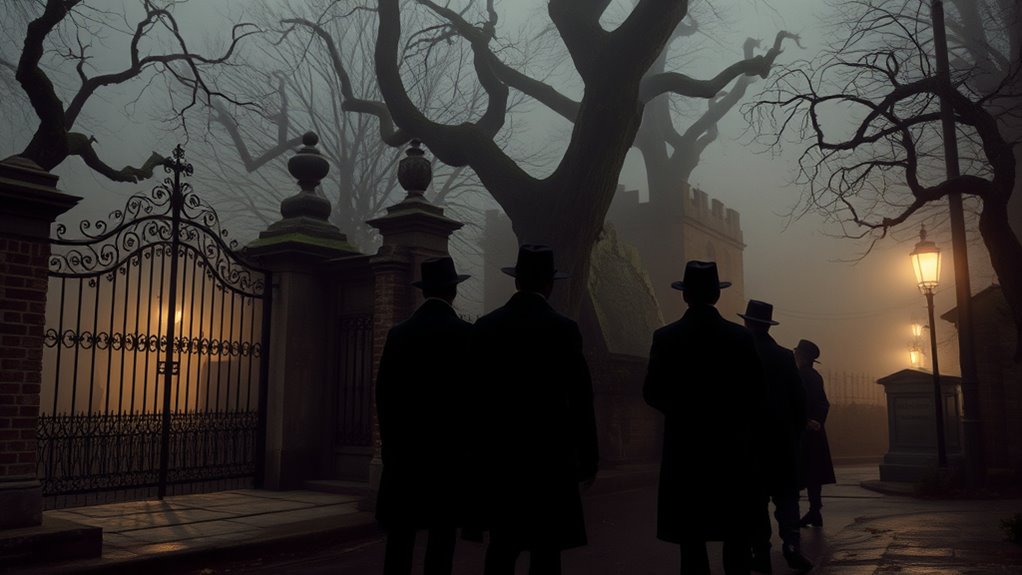
Several theories attempt to explain the Highgate Vampire Panic, ranging from supernatural to psychological origins. Some believe the phenomenon stems from paranormal psychology, suggesting that collective fears and hysteria amplified sightings and reports. Others argue folklore influence played a significant role, as stories of vampires and ghostly apparitions were familiar in local culture, shaping perceptions. The power of suggestion and social contagion may have fueled the frenzy, causing individuals to interpret ordinary occurrences as supernatural. Skeptics see it as mass hysteria or psychological projection, driven by fear and curiosity. While supernatural explanations persist, many experts view the panic as a complex interplay of cultural narratives, psychological factors, and collective imagination, rather than evidence of actual supernatural activity.
Investigations and Explanations
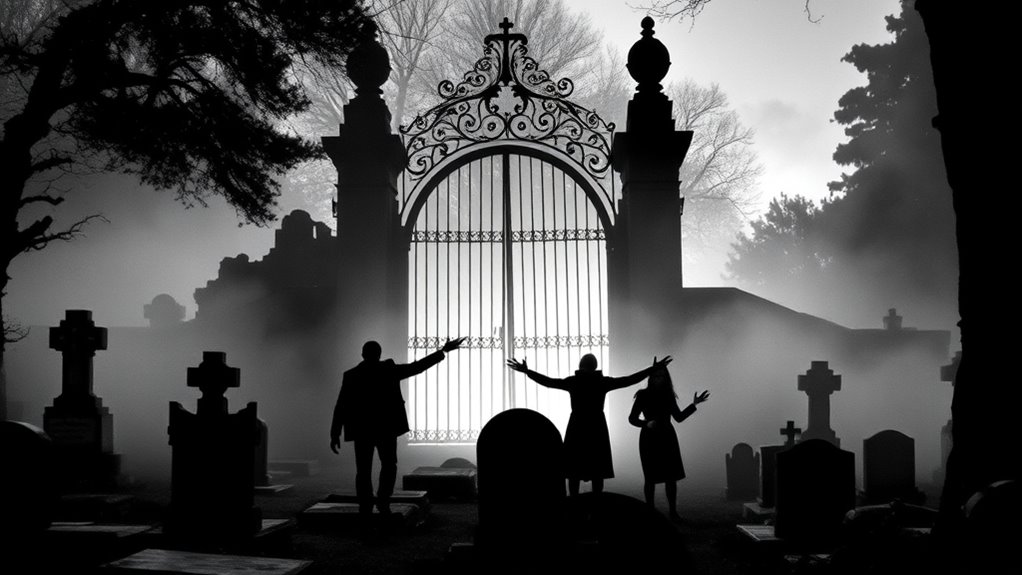
Investigations into the Highgate Vampire Panic have sought to uncover whether there is any factual basis behind the reports or if the entire phenomenon can be explained through natural causes. Researchers examined cryptid sightings, folklore origins, and local legends to understand the origins of these claims.
- Some believe the sightings are rooted in folklore, fueled by stories passed down over generations.
- Others suggest natural explanations like hallucinations or mass hysteria contributed to the panic.
- Skeptics argue that reports of a vampire could be misidentified animals or shadows.
- Investigators looked into the area’s history, finding no concrete evidence of supernatural activity.
- Overall, most explanations point to psychological and environmental factors rather than actual supernatural events.
Cultural Impact and Public Reaction
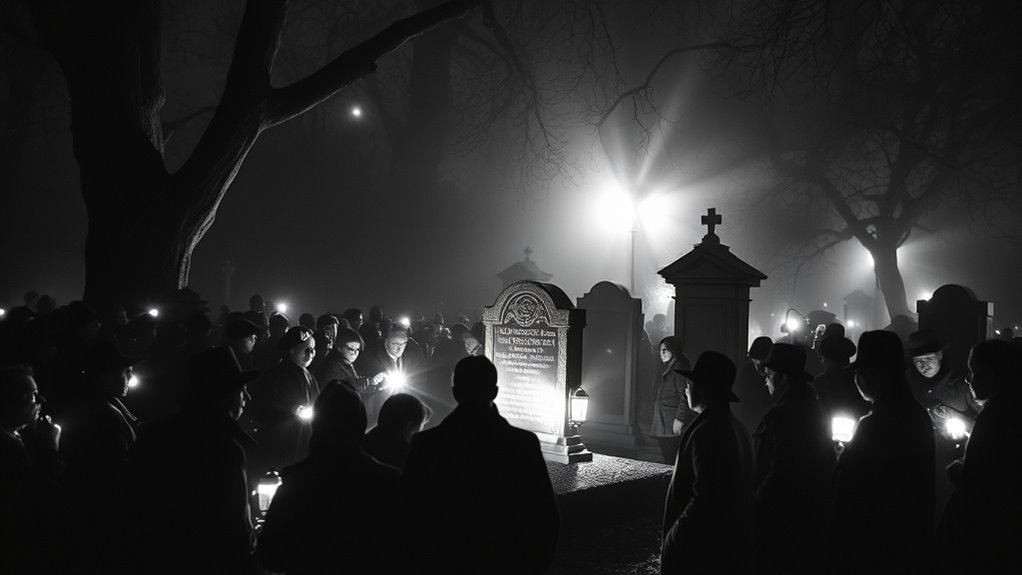
As rumors of the Highgate Vampire spread, they ignited a wave of public fascination and fear that resonated beyond the local community. Media sensationalism played a significant role, amplifying stories and fueling public paranoia. Newspapers and TV reports exaggerated sightings and encounters, turning a local legend into a nationwide phenomenon. You might have noticed how headlines focused on danger and mystery, heightening anxiety and curiosity simultaneously. This coverage created a sense of urgency and suspicion, leading people to believe in an actual supernatural presence. The cultural impact was profound, inspiring books, documentaries, and debates about the supernatural. Public reaction ranged from skepticism to outright fear, with many feeling compelled to explore or avoid the infamous area. The panic left a lasting mark on collective imagination and media portrayal of the supernatural.
Theories of Mass Hysteria
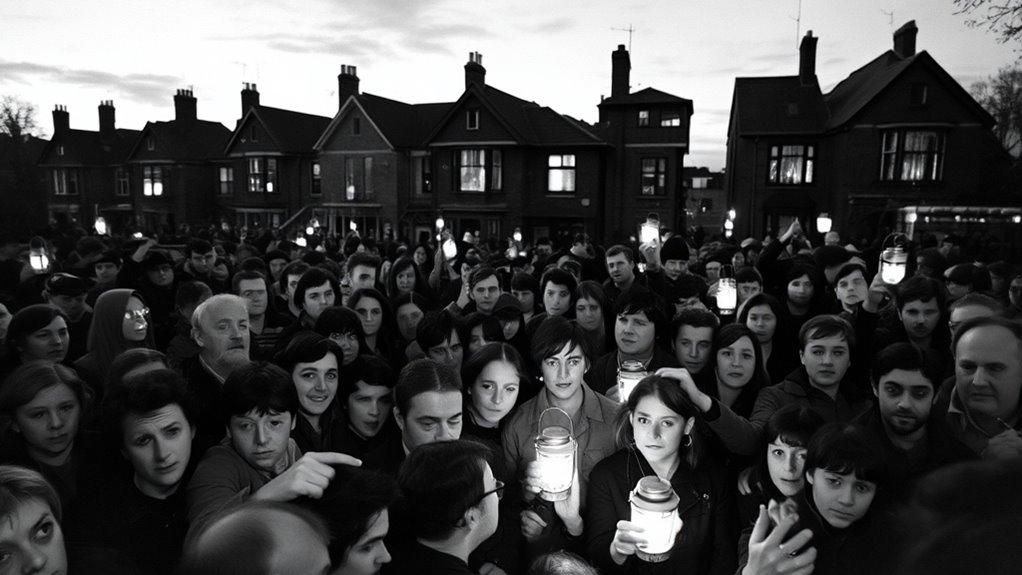
The widespread media coverage and public fascination surrounding the Highgate Vampire created fertile ground for mass hysteria to take hold. Psychological factors, such as fear and suggestibility, amplified the panic, while social dynamics fueled the spread of rumors. You might notice:
- How collective anxiety heightened individual fears
- The role of rumors in shaping perceptions
- Peer influence causing people to act irrationally
- Media sensationalism intensifying the hysteria
- The tendency to seek explanations in supernatural threats
These elements combined to create a feedback loop, making the vampire story seem more real. Theories suggest that the panic was less about an actual vampire and more about psychological and social responses to uncertainty and fear. This explains why the event spiraled so rapidly.
Legacy and Modern Interpretations
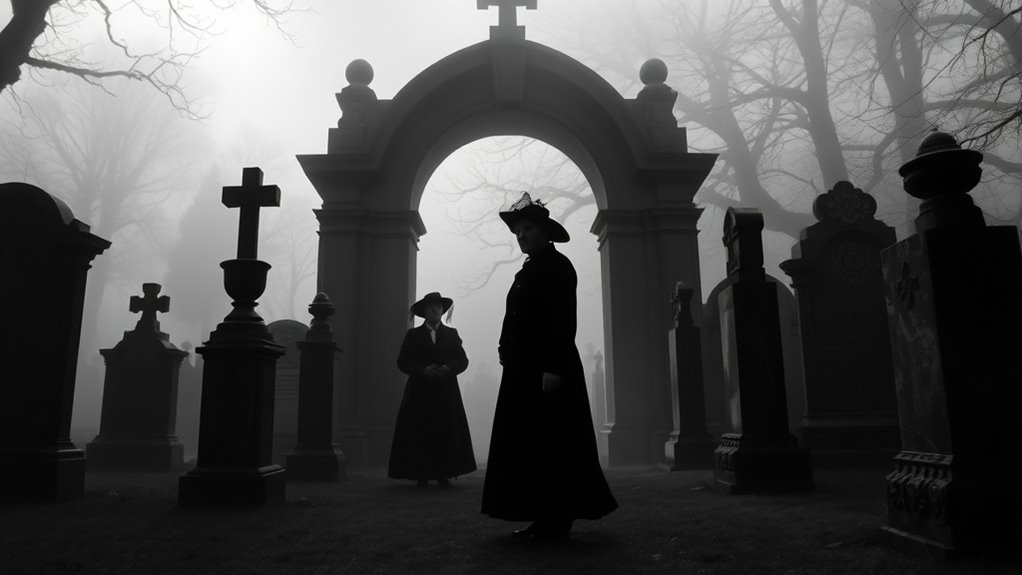
The Highgate Vampire Panic left a lasting mark on popular culture and how we interpret mass hysteria today. It became a prime example of how urban legends can spiral into widespread beliefs, blurring the line between folklore and reality. Modern folklore analysis views this event as a reflection of societal fears and the human tendency to create narratives around the unknown. You might see parallels in other mass hysteria incidents, where collective imagination takes hold, fueled by media and social dynamics. The story’s legacy influences contemporary discussions on urban legends, emphasizing their role in shaping cultural identity and collective psychology. Understanding this helps you appreciate how folklore evolves and persists, often revealing deeper truths about societal anxieties and the power of storytelling.
The Enduring Mystique of Highgate
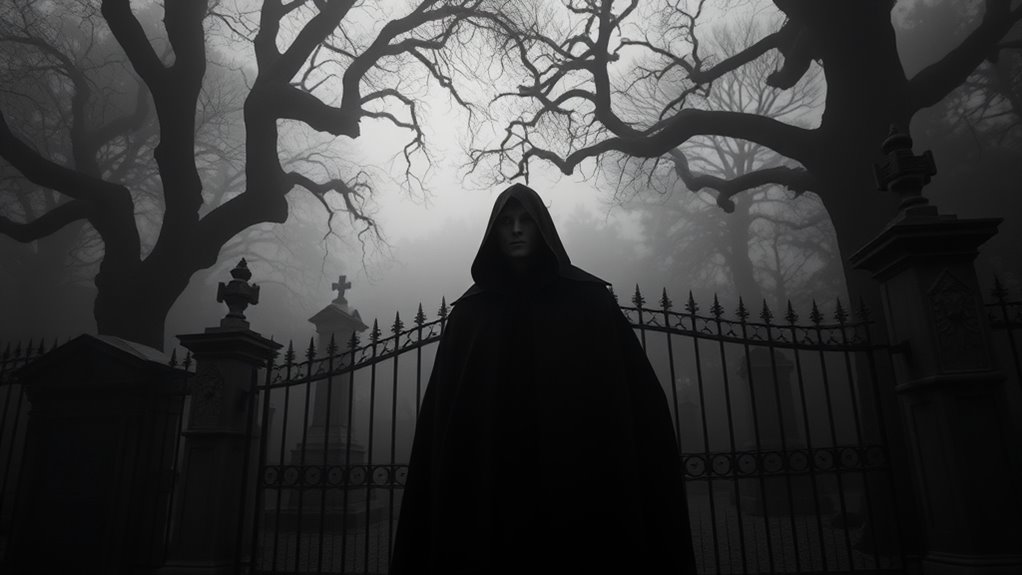
The story of the Highgate Vampire continues to captivate imaginations long after the initial panic faded. Its place in urban legends keeps it alive, fueling curiosity and debate. This folklore evolution shows how stories transform, blending fact and fiction over time. You might hear locals and enthusiasts share tales that deepen the mystery, making Highgate a symbol of supernatural intrigue. The vampire legend persists through books, documentaries, and online discussions, reinforcing its status. It’s not just a haunting story but an enduring part of London’s cultural fabric. The mystique endures because it taps into universal fears and fascination with the unknown. Whether believed or not, the legend’s power lies in its ability to evolve and inspire new generations to explore the eerie allure of Highgate.
Frequently Asked Questions
Were There Any Physical Remains or Evidence Found Related to the Vampire Sightings?
You wonder if any physical remains or forensic evidence linked to vampire sightings were found. During investigations, no concrete physical remains, such as blood, bones, or other forensic evidence, were discovered that confirm vampire activity. Authorities and researchers examined the site thoroughly but found no tangible proof. While eyewitness accounts persisted, the lack of physical remains means there’s no definitive forensic evidence supporting the existence of vampires in the area.
How Did Local Residents Perceive the Highgate Vampire Panic at the Time?
You see, during the highgate vampire panic, local residents viewed it as a mix of urban legends and genuine fear. Community reactions ranged from skepticism to panic, with some people dismissing reports as hoaxes while others believed in the supernatural threat. This blend of myth and fear created a tense atmosphere, where rumors spread quickly, and many residents felt uneasy about the mysterious sightings, fueling the overall hysteria.
Did Any Celebrities or Notable Figures Endorse or Dismiss the Legend Publicly?
Like sparks igniting a fire, celebrity opinions and media coverage fueled the legend’s spread. Some notable figures dismissed the vampire stories as hoaxes, trying to douse the flames of fear. Others, whether genuinely convinced or seeking attention, hinted at supernatural possibilities. Their endorsements or dismissals kept the legend alive in public discourse, shaping how people perceived the eerie tales and adding an extra layer of intrigue to the Highgate story.
What Role Did Local Folklore or Earlier Myths Play in Shaping the Legend?
You realize that local folklore and earlier myths heavily influence legends like the vampire stories. Superstitious beliefs shape how people interpret strange occurrences, fueling fears of supernatural creatures. Mythological influences, such as vampire legends from Eastern Europe, are woven into local tales, creating a rich tapestry of superstition. These traditions reinforce the idea that such beings could exist, making the legend more believable and persistent in community memory.
Are There Any Documented Psychological Profiles of the Main Witnesses Involved?
You’d find that documented psychological profiles of the main witnesses often highlight eyewitness biases and psychological trauma, which influenced their perceptions. These factors can cause witnesses to interpret ambiguous events as supernatural encounters. Their memories might be distorted by fear or stress, making them more prone to believe in vampires. Understanding these psychological aspects helps explain why some witnesses reported such vivid, convincing experiences despite limited physical evidence.
Conclusion
So, next time you hear about a vampire in Highgate, remember it’s probably just a bunch of folks more enthusiastic for a thrill than actual bloodsucking. The legend’s just another excuse to scare yourself silly and blame it on “mass hysteria.” After all, who needs reality when you can have a spooky story that keeps everyone talking—and maybe sleeping with the lights on? Cheers to the timeless charm of urban legends!




